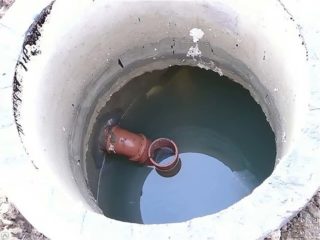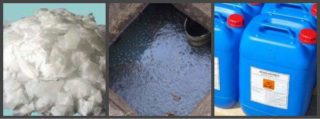Country houses are often equipped with local sewerage systems. All sewage and sewage are discharged into a special pit dug near the house. It fills up quickly and, moreover, smells unpleasant, so the owners are faced with the question of cleaning it. If the container is not cleaned, the contents can spill out and seriously pollute the environment, including pathogenic bacteria. Previously, this problem was dealt with only mechanically. Today there are options for other types of cleaning. After reading this article, you will learn how to clean the cesspool with the help of chemicals, while disinfecting and disposing of waste water.
When to clean the pit
So, when do you need to clean these containers:
- The larger the pit, the less often you can resort to emptying it. So a pit with a volume of 2 cubic meters can be cleaned after several years. However, it is much easier to deal with small amounts of sewage. Preventive cleaning will save you future problems.
- The first signal may be the slow permeability of water in the plumbing, supplied to the pit. That is, it is full and there is nowhere to go for the liquid.
- Another alarm bell is the accumulation of insects above the drain hole, the so-called drain flies. They, in turn, can be carriers of pathogenic microbes.
- The formation of sludge on the bottom and walls of the cesspool, which prevents the passage of liquid through the filter.
- The appearance of a fetid odor due to fermentation and the presence of pathogenic microbes.
- In general, pit cleaning should be done at least once a year.
Cleaning methods without pumping
One of the most effective methods for cleaning local sewer pits is dry cleaning. This is the oldest and therefore well-studied technique. With the help of formaldehydes, this procedure has been carried out for centuries.
The task of cleaning the pit without pumping out is to dissolve solid sewage, transforming them into a liquid homogeneous mass, which is easily absorbed into the soil through the drainage.
Today, they use for this purpose:
- formaldehyde;
- ammonium compounds;
- bleach;
- oxidative nitrates.
Formaldehyde is almost never used lately, as this substance is a carcinogen and very toxic. Instead, less dangerous and effective modern substances are used.
They decompose solid biomass well, kill unpleasant odors, pathogenic and pathogenic bacteria, ammonium compounds. But if you have one cesspool, into which both feces and detergents (for showers, washing, dishes) are drained, then the ability of this substance to break down decreases. Recycled waste, after all, should not be poured into the soil of the site, it must be removed. Another detail to pay attention to is that ammonium compounds corrode metals. If the sewer system has metal frames or parts, they will quickly become unusable. And for the price, this tool is the most expensive.
Another way to clean cesspools is to use bleach.This tool disinfects liquids well, and also has a very reasonable price. But bleach, like formaldehyde, is highly carcinogenic and toxic to the human body. You need to use it, observing all the precautions indicated on the package. It is necessary to store this drug in a dark place, since under the influence of sunlight, bleach decomposes and, as a result, active chlorine loses its properties.
The safest method for cleaning sewer wells for humans is the use of nitrate oxidants. In their composition, they are close to this type of fertilizer. Oxidants react with waste water and feces, decompose biological inclusions and sediments, turning everything into a homogeneous mass, and also perfectly neutralize odors and destroy the larvae of harmful insects. Nitrate oxidizers are suitable for processing sewage containing any household chemicals and food waste. This tool is well received by many consumers. It is suitable for cleaning not only pits, but also the sewer system. High performance indicators are achieved by the presence of surfactants in the composition. Of the shortcomings, only the high price for this drug can be distinguished.
Prevention to reduce the number of pit cleanings
The most common problem is silting of the bottom and walls of the pit, which impairs fluid drainage. To prevent this from happening, you need to regularly rinse the pit with plenty of water once every two months. Liquid will seep into the ground and the walls will become more accessible for cleaning. Then apply chemicals to reduce the amount of solid waste, which will prevent the accumulation of sludge.
In winter, you can face the problem of liquid freezing in the sump. To prevent this from happening, you need to timely use chemicals, which, it should be noted, are not afraid of frost and perform their function at any temperature.
The use of chemical cleaning agents should be started when the pit is filled with sewage no more than 2/3 of its volume.
But all these actions may not be enough if the required volume of the sewer pit was not provided during the construction of the house. During operation, it turned out that it was too small and no substances could cope with the processing of biomass. In this case, you can resort to the reconstruction of the old tank, with the aim of increasing it or the construction of another one, connected by the overflow to the first. You also need to take care of the thermal insulation of the cesspools to prevent them from freezing in winter.
Methods versus pit pumping
Modern chemicals for the cesspool, of course, greatly facilitate the operation of this structure. They can be used to decompose biomass and improve odor at any time of the year. Thanks to the variety, it is possible to find a product that is suitable for hard water, liquids with chlorine or detergents, and for the decomposition of paper and food waste. As a result of their use, it is possible to reduce the number of pumping out of the pit with the help of a sewer machine, which will save a substantial amount of money.
However, no newfangled means can completely exclude mechanical cleaning of the pit from hard and silt deposits. There is still no complete alternative to the use of suction of faeces and sewage.











